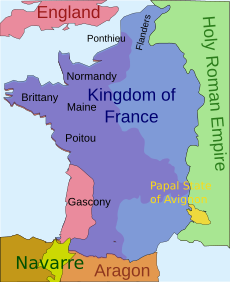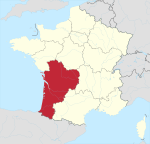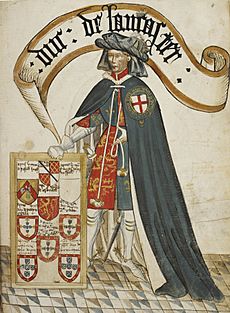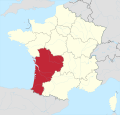Battle of Bergerac facts for kids
Quick facts for kids Battle of Bergerac |
|||||||
|---|---|---|---|---|---|---|---|
| Part of the Gascon campaign of the Hundred Years' War | |||||||
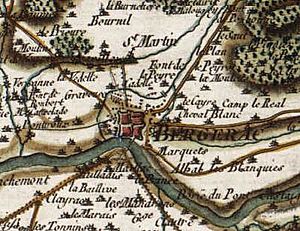 18th-century map showing Bergerac within its defences, and the bridge and suburbs south of the Dordogne |
|||||||
|
|||||||
| Belligerents | |||||||
| Commanders and leaders | |||||||
| Strength | |||||||
| 1,200 men-at-arms (of whom 700 were Gascons) 1,500 English longbowmen 2,800 Gascon infantry |
1,600 men-at-arms Large number of infantry |
||||||
| Casualties and losses | |||||||
| Very light | Over 600 men-at-arms killed; many captured Large number of infantry killed |
||||||
The Battle of Bergerac was a big fight between English-Gascon and French armies. It happened in August 1345 in the town of Bergerac, Gascony. This battle was part of the long Hundred Years' War.
In early 1345, King Edward III of England planned a major attack on France. He sent smaller forces to Brittany and Gascony. Gascony was very important to England because of its trade. The French focused on defending northern France, leaving fewer soldiers in the southwest.
Henry of Grosmont, the Earl of Derby, arrived in Gascony in August. Instead of moving slowly, he decided to attack the main French army directly at Bergerac. He surprised and defeated the French forces led by Bertrand I of L'Isle-Jourdain and Henri de Montigny. The French lost many soldiers and the town. This was a big win for England and Gascony. It changed the balance of power in the region. This victory, and others that followed, led people to call Henry of Derby "one of the best warriors in the world."
Contents
Why Gascony Was Important
For a long time, English kings also held lands in France. This meant they were like tenants, or vassals, to the French kings. By 1337, France had taken back most of these lands. Only Gascony in the southwest and Ponthieu in the north were left.
People in Gascony preferred being linked to the distant English king. He usually left them alone. The French king, however, wanted to control their affairs more closely. After some disagreements, King Philip VI of France decided to take Gascony back from King Edward III of England. This started the Hundred Years' War in 1337, which lasted for 116 years.
Gascony was very important for England's money. Each year, over 1,000 ships left Gascony. They carried huge amounts of wine. The taxes on wine from Bordeaux, Gascony's capital, brought in more money for England than all other taxes combined. Bordeaux was a big city, even larger and richer than London.
However, French attacks had made English Gascony smaller. It had to import food, mostly from England. If ships couldn't get through, Gascony would starve, and England would lose a lot of money. The French knew this. Even though Gascony started the war, Edward III didn't send many soldiers there at first. Gascons often had to fight the French on their own.
The border between English and French lands in Gascony was confusing. Many landowners had scattered properties. They might owe loyalty to different kings for different parts of their land. Small estates had fortified towers, and larger ones had castles. Fortified towns grew up around bridges and river crossings. These were important for collecting tolls and controlling movement.
By 1345, after eight years of war, England only controlled a narrow strip of land along the coast. It stretched from Bordeaux to Bayonne. The French had strong forts all over what used to be English Gascony. Some of these forts were very close to Bordeaux. For example, Libourne was only about 20 miles (32 km) away. Blaye was on the river and could stop ships going to Bordeaux. Langon blocked river travel south of Bordeaux.
Military Plans for 1345
In early 1345, King Edward III decided to attack France from three directions. A small force would go to Brittany. A slightly larger force, led by Henry, Earl of Derby, would go to Gascony. The main English army would go with Edward to northern France.
Before Derby arrived, an advance force led by Ralph, Earl of Stafford, sailed to Gascony in February. Derby was made the King's commander in Gascony in March 1345. He was given permission to raise 2,000 soldiers in England and more in Gascony. Derby had a lot of freedom to make his own decisions. His orders were simply: "if there is war, do the best you can."
The French decided to defend their lands in the southwest. They knew the English planned attacks in three places. But they didn't have enough money to raise a large army for each area. They thought the main English attack would be in northern France. So, they sent most of their soldiers there. This left the southwest to defend itself.
Events Before the Battle
Derby's army left England in late May. Bad weather delayed their journey for several weeks. They finally sailed on July 23. The Gascons, expecting Derby earlier, started fighting without him. They captured two castles, Montravel and Monbreton, in early June. This broke a peace agreement signed in 1343.
Stafford then began to besiege Blaye, a French fort north of Bordeaux. He left Gascon soldiers there and moved to Langon, south of Bordeaux, to start another siege. Both places could be easily supplied by ships. The French quickly called for more soldiers.
Meanwhile, small groups of Gascons raided French territory. Some local French lords even joined them. These raids tied down most of the weak French garrisons. Large areas were left undefended.
King Edward III's main army sailed on June 29. They were scattered by a storm and had to return to English ports. After weeks on ships, the soldiers and horses needed to rest. This delay meant Edward's main army couldn't attack France before winter. Knowing this, King Philip VI of France sent more soldiers to Brittany and Gascony. Peter, Duke of Bourbon was made the French commander in Gascony on August 8. He set up his base at Agen.
On August 9, 1345, Derby arrived in Bordeaux. He had 500 knights, 500 mounted archers, and 1,000 English and Welsh foot archers. After two weeks of getting ready, Derby marched his army to Langon. He met Stafford there and took command of all the forces.
Stafford had been fighting a careful war, focusing on small sieges. But Derby had a different plan. He wanted to attack the main French army before it was fully ready. The French, hearing Derby had arrived, gathered their forces at Bergerac. This town was important because it had a key bridge over the Dordogne river. The French commander there was Bertrand I of L'Isle-Jourdain. Another French force, led by Henri de Montigny, was besieging a nearby castle called Montcuq.
After a meeting, Derby decided to attack Bergerac. Capturing the town would give the English-Gascon army a strong base. It would also force the French to stop besieging Montcuq. And it would cut off French communication between forces north and south of the Dordogne river. The English believed that if they could defeat the French army, the town would be easy to take.
The Battle of Bergerac
Around mid-August, Derby marched from Langon. He had 1,200 knights (700 of them Gascons), 1,500 longbowmen, and 2,800 Gascon foot soldiers. The French near Bergerac had 1,600 knights and many other soldiers. Derby's army moved quickly and surprised the French. We don't know the exact date of the battle. Some historians say Bergerac fell on August 26, others on August 24.
The exact place where the first part of the battle happened is also unknown. The French were either tricked out of Bergerac or were leaving their siege of Montcuq. Either way, they were caught on the road by the English-Gascon army. English archers shot many arrows at them. Then, the English-Gascon knights charged. The French army broke and ran towards the St. Madeleine suburb of Bergerac. This was at the south end of the bridge.
The English-Gascon soldiers chased them so closely that the French couldn't close the gates on the bridge's outer defense. The attackers pushed onto the bridge. It was 200 yards (180 m) long, narrow, and had a chapel in the middle. The French soldiers guarding the town tried to come out and secure the bridge. But the bridge became jammed with Frenchmen. English archers waded into the river to sandbanks. From there, they could shoot arrows at the panicked French from both sides. Many French soldiers were killed, and many surrendered. Attempts to close the gate at the north end of the bridge failed. A wounded horse fell in the gateway, blocking it. The English-Gascons then attacked the town itself.
Historical accounts differ on what happened next. Some say the town gate was closed. They say the town held out for several days. It supposedly fell only after Derby brought boats upriver to attack a weaker part of the wall. However, most modern historians agree with other sources. These sources say the gate was captured in the first attack, on the same day as the battle, after dark.
Either way, the town was captured. It was then looted, and a lot of supplies and horses were taken. The French soldiers who survived the battle gathered with John, Count of Armagnac. They retreated north to Périgueux.
What Happened Next
The battle and the capture of Bergerac were huge victories. The English and Gascons took a lot of valuable goods from the defeated French army and the town. Over 600 French knights were killed, and many were captured. Many French foot soldiers were also killed. English and Gascon losses were very light.
This was the first of many victories for Henry of Derby. A writer at the time called him "one of the best warriors in the world." Modern historians also praise his leadership. They call him a "superb and innovative tactician" and say his actions were "brilliant in the extreme." One historian described Derby's four-month campaign in 1345 as "the first successful land campaign" of the Hundred Years' War.
From a military point of view, the English-Gascon army now had an important base. This base would help them continue fighting the French. Politically, local lords who weren't sure which side to support now saw that the English were strong again in Gascony. This battle, along with the Battle of Auberoche later that year, changed who had the power in the region.
Images for kids


